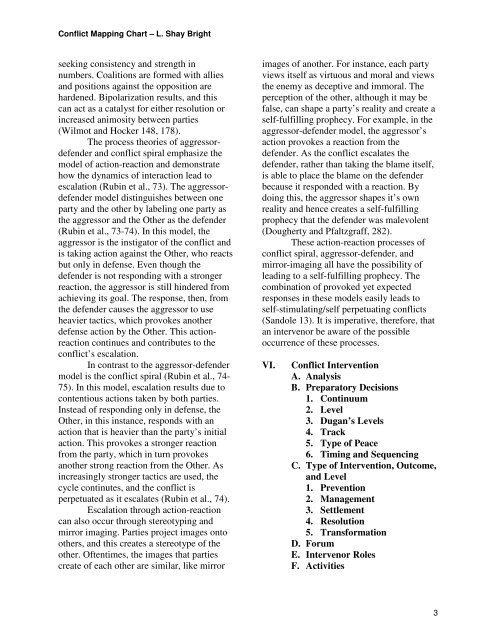The Conflict Mapping Chart By L. Shay Bright To ... - CMSupport.org
The Conflict Mapping Chart By L. Shay Bright To ... - CMSupport.org
The Conflict Mapping Chart By L. Shay Bright To ... - CMSupport.org
You also want an ePaper? Increase the reach of your titles
YUMPU automatically turns print PDFs into web optimized ePapers that Google loves.
<strong>Conflict</strong> <strong>Mapping</strong> <strong>Chart</strong> – L. <strong>Shay</strong> <strong>Bright</strong><br />
seeking consistency and strength in<br />
numbers. Coalitions are formed with allies<br />
and positions against the opposition are<br />
hardened. Bipolarization results, and this<br />
can act as a catalyst for either resolution or<br />
increased animosity between parties<br />
(Wilmot and Hocker 148, 178).<br />
<strong>The</strong> process theories of aggressordefender<br />
and conflict spiral emphasize the<br />
model of action-reaction and demonstrate<br />
how the dynamics of interaction lead to<br />
escalation (Rubin et al., 73). <strong>The</strong> aggressordefender<br />
model distinguishes between one<br />
party and the other by labeling one party as<br />
the aggressor and the Other as the defender<br />
(Rubin et al., 73-74). In this model, the<br />
aggressor is the instigator of the conflict and<br />
is taking action against the Other, who reacts<br />
but only in defense. Even though the<br />
defender is not responding with a stronger<br />
reaction, the aggressor is still hindered from<br />
achieving its goal. <strong>The</strong> response, then, from<br />
the defender causes the aggressor to use<br />
heavier tactics, which provokes another<br />
defense action by the Other. This actionreaction<br />
continues and contributes to the<br />
conflict’s escalation.<br />
In contrast to the aggressor-defender<br />
model is the conflict spiral (Rubin et al., 74-<br />
75). In this model, escalation results due to<br />
contentious actions taken by both parties.<br />
Instead of responding only in defense, the<br />
Other, in this instance, responds with an<br />
action that is heavier than the party’s initial<br />
action. This provokes a stronger reaction<br />
from the party, which in turn provokes<br />
another strong reaction from the Other. As<br />
increasingly stronger tactics are used, the<br />
cycle continutes, and the conflict is<br />
perpetuated as it escalates (Rubin et al., 74).<br />
Escalation through action-reaction<br />
can also occur through stereotyping and<br />
mirror imaging. Parties project images onto<br />
others, and this creates a stereotype of the<br />
other. Oftentimes, the images that parties<br />
create of each other are similar, like mirror<br />
images of another. For instance, each party<br />
views itself as virtuous and moral and views<br />
the enemy as deceptive and immoral. <strong>The</strong><br />
perception of the other, although it may be<br />
false, can shape a party’s reality and create a<br />
self-fulfilling prophecy. For example, in the<br />
aggressor-defender model, the aggressor’s<br />
action provokes a reaction from the<br />
defender. As the conflict escalates the<br />
defender, rather than taking the blame itself,<br />
is able to place the blame on the defender<br />
because it responded with a reaction. <strong>By</strong><br />
doing this, the aggressor shapes it’s own<br />
reality and hence creates a self-fulfilling<br />
prophecy that the defender was malevolent<br />
(Dougherty and Pfaltzgraff, 282).<br />
<strong>The</strong>se action-reaction processes of<br />
conflict spiral, aggressor-defender, and<br />
mirror-imaging all have the possibility of<br />
leading to a self-fulfilling prophecy. <strong>The</strong><br />
combination of provoked yet expected<br />
responses in these models easily leads to<br />
self-stimulating/self perpetuating conflicts<br />
(Sandole 13). It is imperative, therefore, that<br />
an intervenor be aware of the possible<br />
occurrence of these processes.<br />
VI. <strong>Conflict</strong> Intervention<br />
A. Analysis<br />
B. Preparatory Decisions<br />
1. Continuum<br />
2. Level<br />
3. Dugan’s Levels<br />
4. Track<br />
5. Type of Peace<br />
6. Timing and Sequencing<br />
C. Type of Intervention, Outcome,<br />
and Level<br />
1. Prevention<br />
2. Management<br />
3. Settlement<br />
4. Resolution<br />
5. Transformation<br />
D. Forum<br />
E. Intervenor Roles<br />
F. Activities<br />
3


